Key Black environmental leaders
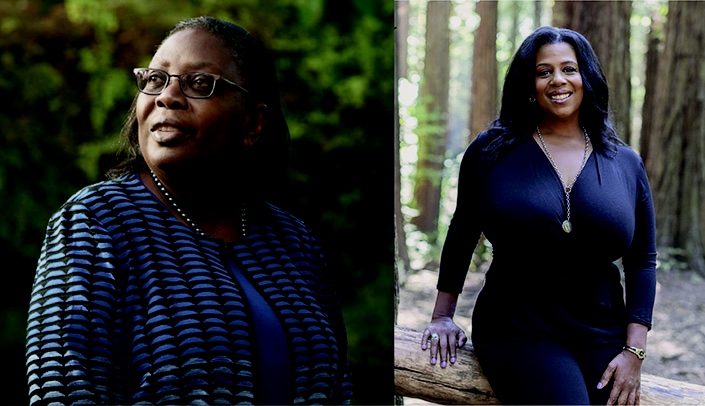
From left, Dorceta Taylor, PhD, and Rue Mapp
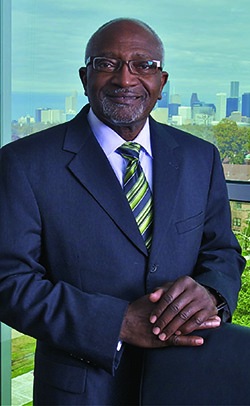
Robert Bullard, PhD, Dorceta Taylor, PhD, and Rue Mapp are three key people who have powered the environmental justice movement. These three people have spent their careers working to bring others to action to create a more just and cleaner environment for all.
Dr. Bullard is a professor of urban planning and environmental policy at Texas Southern University. He is considered the “father of environmental justice” because of his work that began in the 1970s on the environmental injustices faced by minority communities in Houston. Dr. Bullard was collecting information for a civil rights lawsuit his wife was filing that challenged the placement of a landfill in a Black community. In an interview with The Guardian, Dr. Bullard said, “we found five out of five landfills in Houston were located in Black neighborhoods, and six out of eight incinerators were in Black neighborhoods.” This led Dr. Bullard to start writing and researching environmental justice, and it set him on his path to become a leader in the movement.
Rue Mapp is the CEO and Founder of Outdoor Afro. A 2009 report about National Park Service (NPS) attendance found that white people made up 78% of NPS visitors. Mapp wanted to increase the diversity of people using preserved natural spaces, so she created a network that celebrates and inspires Black connections and leadership in nature. Outdoor Afro leads nature experiences to empower people of color to be the face of conservation.
Dr. Taylor is a professor of environmental justice at the Yale School of Environment. Her work mainly focuses on environmental racism and diversity within environmental groups. Dr. Taylor has written several books on the subject, including “Toxic Communities: Environmental Racism, Industrial Pollution, and Residential Mobility” and “The Environment and the People in American Cities.” Her most prominent work, which is focused on diversity within environmental groups, is called “The State of Diversity in Environmental Organizations: Mainstream NGOs, Foundations & Government Agencies.” This report is the most comprehensive report on diversity in the environmental justice network.
Although these are a few of the people who are considered the faces of the movement, many leaders are doing great environmental justice work, and we are all environmentalists. As Dr. Bullard said during a talk at Furman University, “Do you breathe air? Then you’re an environmentalist.”
Let’s keep innovating to create a more just and cleaner environment!
Environmental justice in Omaha
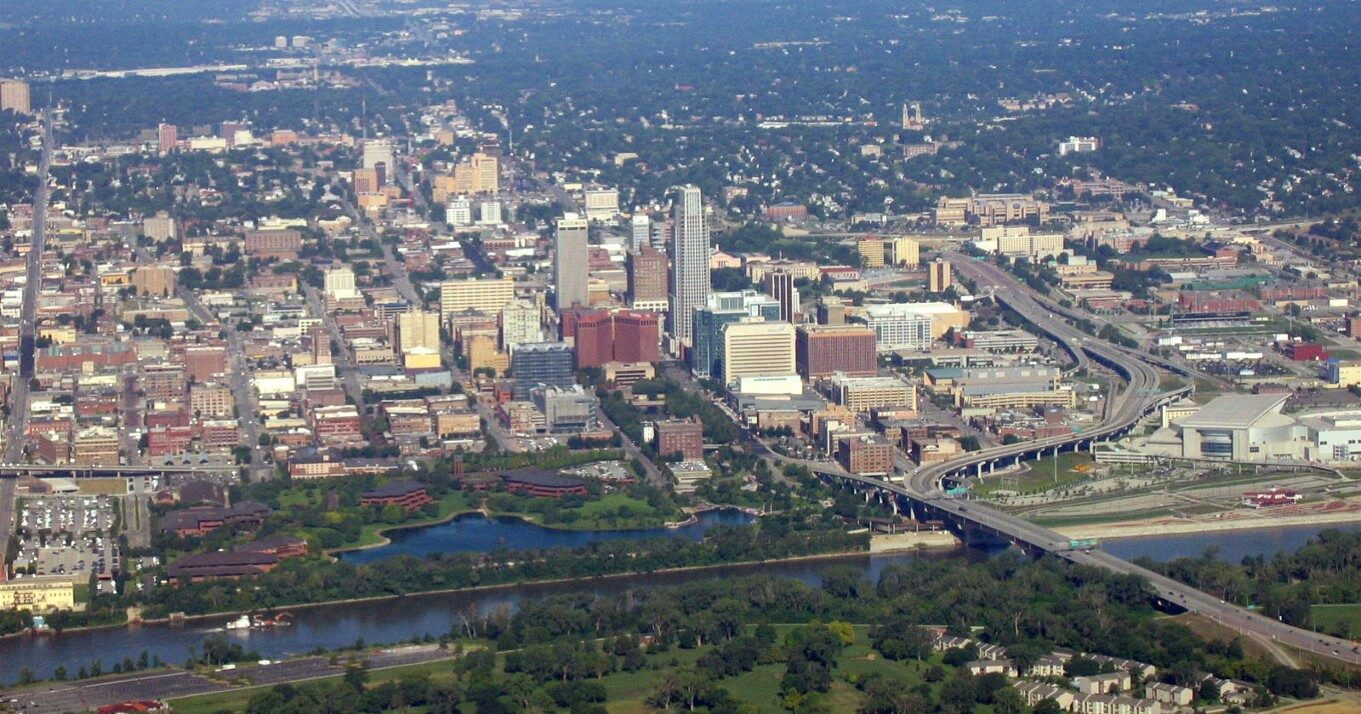
Last week, we wrote about environmental justice and how communities of color are disproportionately impacted by environmental hazards. This week’s article highlights an example of environmental injustice in North Omaha and how collective action and community organizing led to triumph and community healing.
North Omaha has faced a variety of challenges related to unjust development policies throughout history. In 1954, a coal plant was constructed at John J Perishing Drive and Florence Boulevard by Omaha Public Power District (OPPD). Coal plants pollute the air by releasing potent toxins like carbon dioxide, sulfur dioxide, mercury and small particulate matter, which has led to poor air quality and higher rates of asthma in the predominantly African American community. In 2013, the coal plant was ranked “the 16th worst environmental justice offender in the nation” by the NAACP, according to Grist.
The location of this plant in the North Omaha neighborhood caused unjust environmental and health impacts, including frequent code-red air days and a growing asthma rate. According to Toll from Coal, the North Omaha coal plant has caused an average of 18 deaths, 11 heart attacks and 120 asthma attacks per year. Not only did residents face inequity with regard to the quality of the air they were breathing, but emergency room visits exacerbated wealth inequities by putting undue financial burden on North Omaha families.
North Omaha residents demanded accountability. Community leaders organized meetings and educational forums, and residents showed up in record numbers to an OPPD board meeting to push for the coal plant to be retired. The NAACP’s Omaha branch also spoke out in support of the organizers, voicing concerns about the coal plant and air pollution in the community.
Residents’ demands for justice were heard — in 2014, OPPD retired the three oldest coal-generating units and began retrofitting and updating the last two units with more emissions controls. Graham Jordison, a Beyond Coal organizer in North Omaha, described the effort as “a powerful movement here in Omaha” — one that has created partnerships between organizations like the Sierra Club and the Malcom X Foundation, with the ultimate goal of securing a more equitable clean energy system across the state. The retirement of the coal plant was one step toward this future and served as a moment of healing for the North Omaha community.
Environmental justice

February is Black History Month — a time to celebrate achievements and contributions to U.S. history by Black Americans.
It’s also a good reminder to reflect on ongoing inequality in our society. Within the U.S., there are dominant socioeconomic forces that result in lower environmental quality for most communities of color, but especially Black communities, that place them at higher risk of devastation by natural disasters, all of which lead to poor health outcomes.
Communities of color face a variety of environmental impacts as a result of these forces. For example, toxic facilities like landfills and factories are frequently located within communities of color because decision makers know that these communities often do not have the resources and influence to oppose them.
Investments that would help improve environmental quality — such as green spaces and bike lanes — often backfire, leading to gentrification. Residents of color who can no longer afford to live in their home are then displaced to other neighborhoods where toxic facilities already exist. Ultimately, these cyclical events lead to higher pollution levels in the air and water, fewer trees to clean the air, reduced access to healthy food and more challenges in Black communities.
These environmental impacts have serious implications for health outcomes. According to researchers, poor air quality creates a higher risk of getting cancer, asthma, heart disease, cognitive problems and a whole host of other conditions. It also can exacerbate existing conditions. These outcomes are considerably higher for communities of color. According to the Princeton Student Climate Initiative (PSCI), 13.4% of African American children suffer from asthma, compared to only 7.3% of white children.
The PSCI defines environmental justice as “a social justice movement that seeks to dismantle the flawed environmental policies that have long harmed low-income communities and communities of color, and instead pursue policy and development that work to create a sustainable, cooperative, and equitable future for the environment.”
The NAACP and numerous other organizations are working to flip the script and create sustainable investment that brings environmental justice and health to communities of color. The NAACP Environmental and Climate Justice Program works to reduce harmful emissions, advance energy efficiency and clean energy sources (such as wind and solar), strengthen community resilience to natural disasters, and create more livable neighborhoods. See more at the website, including an introductory video and reports and toolkits.
Marking World Wetlands Day
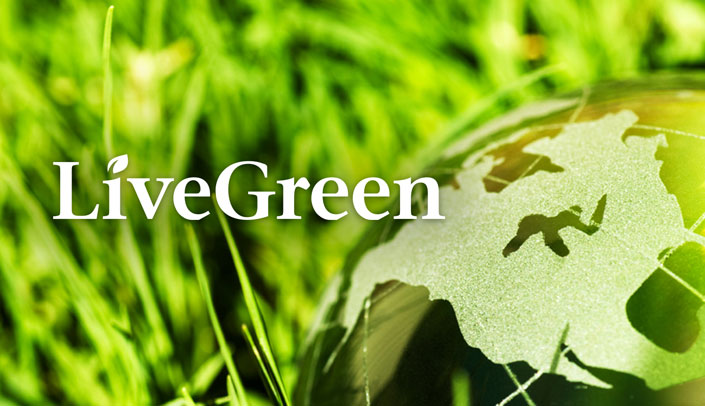
By Blake Van Jacobs
Today is World Wetlands Day.
Wetlands are defined as “areas that are inundated or saturated by surface or groundwater at a frequency and duration sufficient to support . . .a prevalence of vegetation typically adapted for life in saturated soil conditions. Wetlands generally include swamps, marshes, bogs and similar areas” (US Army Corps of Engineers, 1987). Both freshwater and saltwater wetlands provide natural, social and economic support to humans and nature by storing and cleaning water, helping feed people, underpinning the global economy and keeping humans safe.
World Wetlands Day helps raise global awareness about the vital role wetlands play for people and our planet. It is celebrated on Feb. 2 to mark the adoption of the Convention on Wetlands, which took place in 1971 in the Iranian city of Ramsar, on the shores of the Caspian Sea.
Humans use water faster than nature can replenish. This is where wetlands help us out.
According to the Nebraska Game and Parks Commission, “Wetlands act as a filter, slowing water down and allowing sediment and many pollutants to settle out. As the water slowly moves through the wetland, a series of chemical transformations take place that tie-up or alter a variety of pollutants. The net result is that the water leaving a wetland is of higher quality than the water entering the wetland.” Eighty percent of the nitrate pollution entering wetlands is converted to harmless nitrogen gas by the time the water exits the wetland.
As climate change worsens and the threat of flooding becomes an even more potent risk, wetlands will provide another unmonetized benefit: they have the capacity to hold up to 1.5 million gallons of floodwater per acre. Wetlands also are a carbon sink and can hold up to twice as much carbon as forests can. As we work to fight climate change and reduce emissions to zero, wetlands are a crucial resource that must be protected at all costs.
Nebraska’s wetland area has been decreasing, and the state has just under two million acres of wetlands — down from three million acres in 1800. Nebraskans can help protect wetlands by:
- Using pesticides and fertilizers sparingly;
- Planting native plants and avoiding invasive species;
- Reducing our carbon footprint and pollution levels; and
- Conducting outreach and information campaigns for elected officials to protect wetlands.
Blankets for Kids
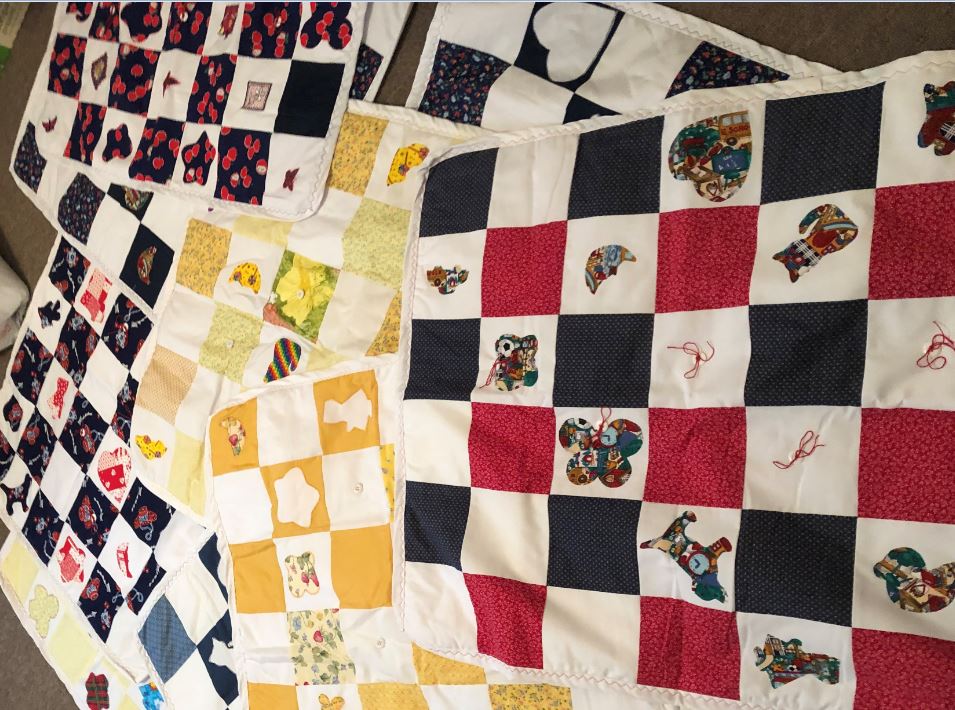
By Melanie Stewart
As you know, lab coats cannot be thrown away. To protect our patient’s safety, the person that wore it, and the Med Center, they need to have names/branding removed. You may recall that LiveGreen collects these coats, removes those items and donates them to local schools. They provide protection for the student in science, art, or cooking classes, and the school doesn’t have to buy single use plastic ones.
This was easy as we switched brands, as old coats had names on pockets and a patch with the brand. But as new-brand coats are being sent in, it’s increasingly difficult to remove the necessary items and leave the coat in a usable condition. Some coats are sent to research labs on campus, as they are more likely to need extra coats, and often don’t have names embroidered on.
The rest have the name and patch cut out, and are sent to Maurine Bryan. Maurine is the 88 year-young mother of Julie Garfield Oltman, business manager in Strategic Communications. Maurine has been sewing for most of her life, starting in 4-H. She’s now known as the “resident tailor” at Elmwood Tower; taking in clothes, fixing buttons and zippers, and even performing “surgery” on grandkid’s stuffed toys or dolls.
Maurine cuts squares from the lab coats and then sews the blankets with pieces of fabric left from other projects. She started making lap blankets (examples shown in picture above) for seniors in her community, who were often cold, and these were the perfect size to cover them without interfering with a wheelchair. She repurposed the lab coat pockets on these blankets as a place for someone to keep a tissue or a remote control, and uses the buttons to keep the layers together.
Now most of her blankets now go to kids in need through Completely Kids. As you may imagine, non-profits see a lot of different people, and there’s always a need—and that was before the pandemic. Kids get a pocket to hide a toy or tissue, and extra pockets are donated to another seamstress who makes bags that hang on walkers, providing extra pocket on the outside.
Maurine is modest so she hasn’t counted, but Julie (who is also the delivery driver) knows she’s made more than 50. A wonderful way to upcycle these lab coats and help people in need.
Construction and Demolition Waste
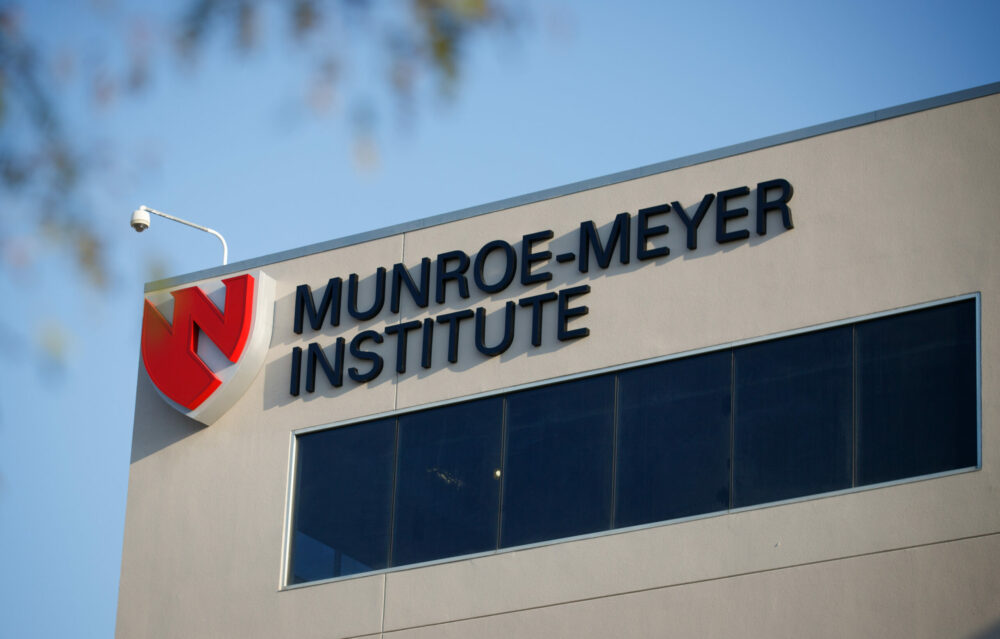
By Blake Van Jacobs
When buildings are renovated a lot of waste is generated and it’s pretty common for that waste to go straight to the landfill. It is an incredibly wasteful process with little done to recycle or reuse the materials—from a time perspective it’s easier to demo everything and get it out of the building and out of the way as fast as possible.
While the new Munroe Meyer Institute (MMI) is being remodeled to meet their needs, Facilities tested out a new process with the contractor to divert the waste from the landfill to reuse or recycle the materials. The building materials to be diverted consist of concrete, wood, scrap metal, cardboard, and mixed metal/plastic recycling from the renovation and new product packing.
As you can imagine these materials are heavy, take up a lot of landfill space, and diverting these materials will help the Med Center make progress towards the Net Zero Waste goal. Net zero waste is defined as “diverting 90 percent of all discarded materials from landfill, incinerators, and the environment.” While a bold goal, campus leaders believe that there are going to be market changes like this that allow UNMC to achieve this goal.
Contractors working on smaller projects share bins on campus and that material is being diverted and tracked as well. We routinely recycle more than 10 tons of material a month, while generally only sending 2-3 tons to the landfill.
Back to the new MMI building. The previous occupant left in a hurry and left a lot of stuff in the buildings, mostly office furniture, but other accessories too—everything from trash cans to breakroom refrigerators. We needed to get it out of the building so work could take place, but there were a lot of items and they were in good shape. Luckily Project Manager John Poulicek found a vendor who could come remove it from the building and find a new home for it. How much did they take? A whopping 141 tons/282,000 pounds!
Since then, contractors have been recycling the building materials mentioned above. The renovation is almost complete and they have diverted a total of 13 million pounds/6,500 tons of waste from the landfill while sending only 1.7 million pounds of waste to the landfill. The project currently has an 86.5% diversion rate, which is a huge success—and will lead to more successes in the future.
(Not) Printing has a huge impact on campus
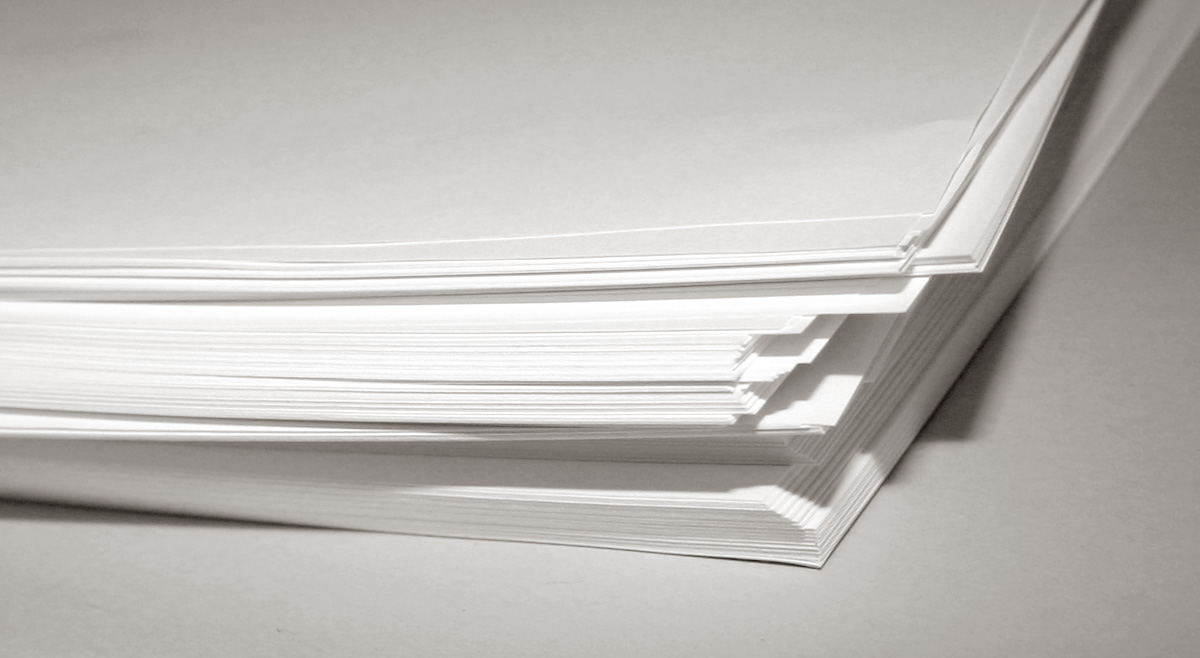
By Melanie Stewart
As we told you before the holidays the Med Center has reduced copier paper use!
How much? In the last three years we have saved a minimum of:
- 62,861,447 sheets of paper
- $379,000 in purchased paper costs
- Doesn’t count labor to deliver, stock, load, transport, or shred, which would be additional savings
- 7,543 trees
- 362,083 lbs of CO2e (164 Metric Tons) which harms human health and is a major contributor to climate change.
As people slowly return to the office and we begin to think about the future of working, how can we stop using so much paper to keep these trends going?
Reduce Printing Needs By:
- Displaying meeting agendas and other visuals on a screen; don’t print handouts. Take notes digitally.
- Use Word’s “Track Changes” feature to edit documents, rather than writing on a printed copy.
- If applicable to your area, laminate common instructions for patient review, only print necessary documents.
- Encourage patients to sign up for One Chart, allowing patient materials and bills to be sent electronically.
- Use OneNote, OneDrive, SharePoint, Teams, and other Office365 tools to share information and avoid printing and faxing.
- Use resources on theITS website for help.
-
- Lock PDFs and other documents (or save as PDF) before sharing to prevent version issues.
There are times when printing is necessary. Before hitting that button:
- Work with UNMC Printing Services if you are printing large quantities; it will save you time, effort and money. Printing Services offers same day, quality copies without the multiple costs associated with producing copies on an office copier.
- Be aware of duplicates; don’t print when information is already available electronically.
- Eliminate blank sheets from documents before printing.
- Set the default on your computer and/or printer to print duplex and black and white (saves additional dollars).
Keep up the good work, and stick to those non-printing habits—don’t fall back in to printing habits if you come back to campus. Still learning? So are we! Here are some resources to help you reducing printing in your area.
Paper not purchased is factored into the Med Center’s Zero Waste goal. By printing less and reducing paper use, we’re able
LED Lighting Changes Yield Impressive Results
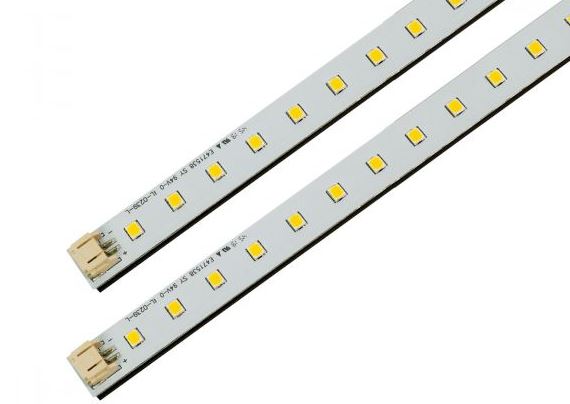
By Melanie Stewart
Two years ago we told you that the metal halide bulbs that were on 24/7 in the lot 50 parking garage were converted to LEDs saving the Med Center $48,000 a year in electricity charges.
We’re amped to tell you that the money saved was paired with and OPPD rebate program to purchase more LED fixtures/bulbs and continue to savings.
Don’t forget, lightbulbs are often sold by wattage, and we’ve learned to associate that with light. More watts does mean a brighter bulb, but it’s actually a measurement of the amount of energy you are using. A 75W bulb uses 75 watts of electricity, but puts off about 1,100 lumens of light. LEDs emit the same number of lumens using substantially less watts. The light comes from small diodes so they are easily dimmable, can be warm or cool, change colors, and emit less heat thereby reducing cooling costs. That control allows for daylight harvesting and motion-sensing so lights are only on, and as bright, when they need to be.
Since that time lights/fixtures have been replaced in:
Administration Building Annex 14/Brown Building
Durham Research Center Bennett Hall
Durham Research Center II College of Nursing
Hixson Lied Operating Rooms Eppley Science Center
Maurer Center for Public Health 4230/AX 10
Core Lab/Blood Bank AX 23/Grounds
Student Life Center Lied Transplant Center
Part of AX 22/Mail Center Old Red Cross Building
All Med Center street lights Bellevue Operation Rooms and outdoor lighting
Parking lot 44
In total, so far, the Med Center has replaced 16,237 fixtures which will save 2,556,831kWh each year. {That calculation takes use into consideration—office space usage compared to operating rooms, exterior lights changing with the seasons etc.} If that seems like a lot of energy, you are right! An average U.S. home used 10,649kWh each year, so this would be enough to power more than 240 homes for a year. The Med Center will avoid $231,630 each year just in electricity costs but there are also additional dollars saved in cooling. The heat put off by the lights had to be compensated with extra cooling that now doesn’t need to be used as well—saving even more. This is especially noticeable with the boom lights in the ORs.
We hope you got a charge out of this update and once more buildings/spaces are complete we’ll be back to enlighten you again.
Plastic is Everywhere
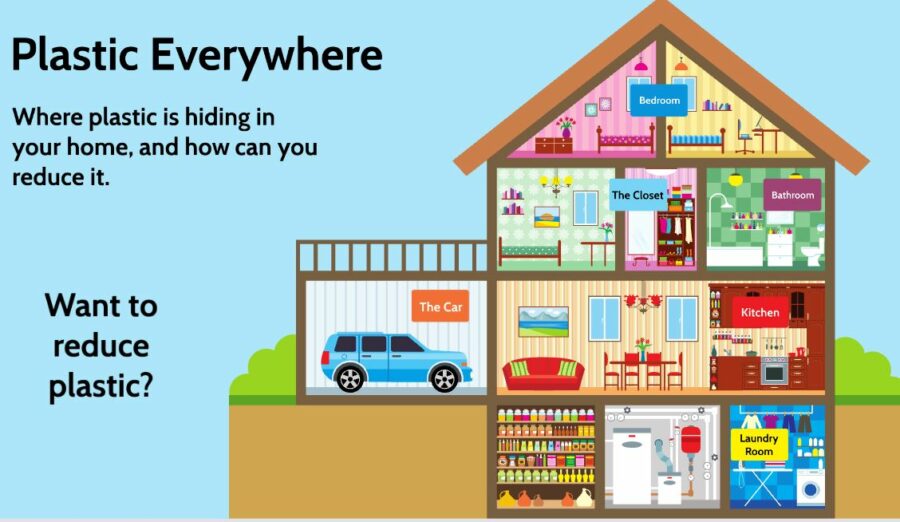
By Melanie Stewart
Plastics can be found in any room of your home. We often think of plastic as water bottles, packaging, or bags, but common household items that contain microplastics that travel through the air and via water ways and are detrimental to the environment. Microplastics have been found in the deepest parts of the ocean, the top of Mount Everest, and everywhere in between—the average American consumes between 39,000 and 52,000 pieces of plastic a year from our food and beverages.
Click through this interactive home to see where plastic can be found as well as alternatives.
To reduce your plastic use, check out your kitchen. When you go shopping, use reusable produce bags instead of the bags provided and bring your own reusable bags to carry out your groceries. Buy food that does not come in plastic packaging and buy in bulk, whenever possible. Opt for reusable plates, cups, and utensils—it saves you money, you’ll eat less plastic, and your dining experience will be better. Store your food in reusable metal, glass, or silicone containers, or cover with a beeswax wrap instead of plastic cling.
There’s a surprising amount of plastic in your bathroom—shampoo/conditioner and body wash bottles, make-up and hair products, OTC medication, toothbrushes and toothpaste…the list goes on. Some items are hard to replace, but there are swaps that can reduce plastic use. Bamboo toothbrushes and toothpaste tabs, bar shampoos and soaps, plastic free menstrual products, and there are companies that are reducing plastic packaging and/or moving to compostable options.
Clothing items that aren’t 100% cotton/linen/wool, etc. also contain plastic…commonly polyester. Alas your fleece top and favorite lounge wear are probably more plastic than anything else, and washing those items puts plastics that are too small to be captured by treatment plant filters right into our waterways. Wash your clothes in homemade laundry detergent (LiveGreen tested recipe here), or with detergent that comes in a box or a biodegradable container.
Plastic is found in fabrics and textiles in our bedrooms and living spaces too. Most rugs, curtains, and carpets are made from synthetic materials which have their own health risks because of the chemicals used in them. Look for items that are sustainably sourced and are made of wood, cotton, bamboo, or wool, with Volatile Organic Compound (VOC) free finishes. Or consider antique and vintage items as they are less likely to contain plastic.
New Elevators in Clarkson Tower
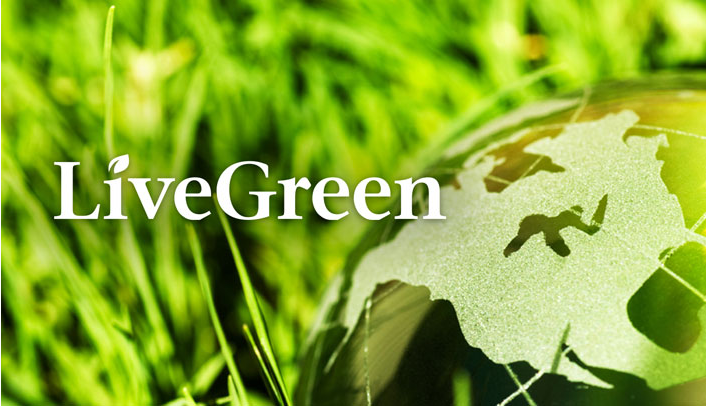
By Blake Van Jacobs
Did you know that the Clarkson Tower elevators are some of the busiest elevators in the state? It may seem surprising, but have you ever rode one of those elevators by yourself? Those elevators were also old, in need of replacement, and that has now been completed for all cars.
The technology used to run elevators has changed dramatically, so the new equipment is more efficient and generally requires less energy to operate.
The biggest energy savings comes from (a lack of) cooling. The old elevators were run by a type of generator which was inefficient and produced a lot of heat. Subsequently, the rooms where the generators were housed got hot and then required us to use a lot of energy to cool the rooms—which made the elevators even more inefficient. The new equipment will cut out the generators that ran the elevators and will no longer need rooms to be constantly cooled for proper operation. This is where the greatest savings on emissions and costs come from for the new elevator system.
The cars themselves already had LED lighting installed, keeping the inside of the car cooler, reducing maintenance costs, and saving energy.
In total, these changes, primarily made for safety, will save the Med Center over $2,300 each year. That number may not change the world, but it add up over time. Changes like this across campus will help us reach our Net Zero Building Emissions goal by 2030 and more importantly, help reduce pollution in our area that leads to climate change and harms human health. Speaking of health, when appropriate, take the stairs—it’s increases your physical activity, burns calories, if you are only going a floor or 2 it’s usually quicker, saves additional energy/emissions, and allows the elevators to move patients/visitors more quickly, giving them a better experience.
To continue to track UNMC’s progress on the sustainability metrics, check out our dashboard! You can see progress on all of our goals there, including emissions, and learn about current and upcoming projects that impact our goals.
